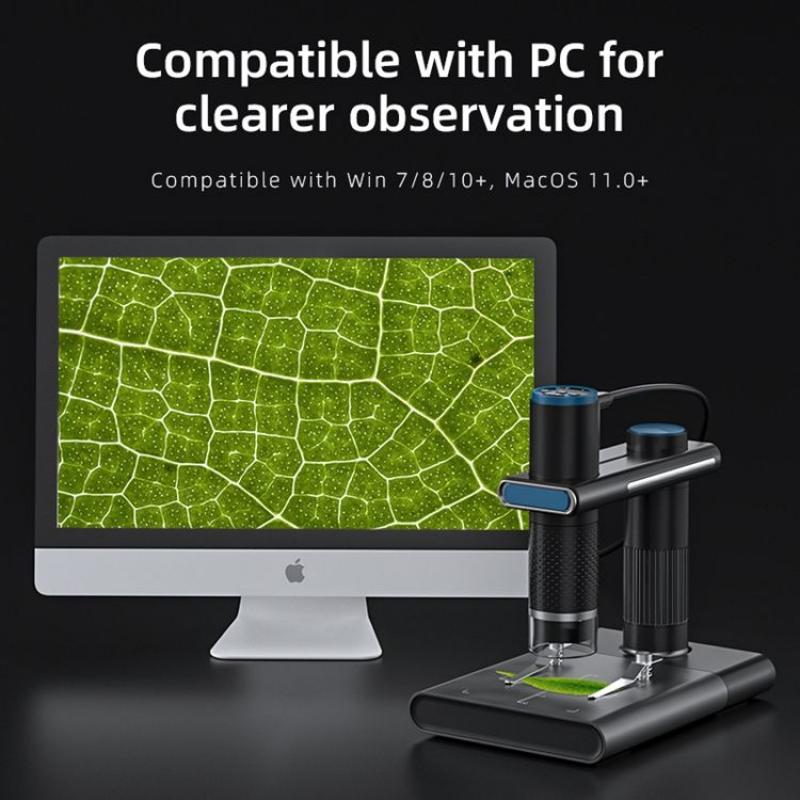How Do Onion Cells Look Under The Microscope ?
Onion cells appear rectangular in shape and have a distinct cell wall and nucleus when viewed under a microscope. The cell wall is visible as a thin, dark line surrounding the cell, while the nucleus appears as a large, round structure within the cell. The cytoplasm, which fills the space between the cell wall and nucleus, may also be visible as a lighter area. Additionally, onion cells may contain small, dark-staining structures called plastids, which are involved in photosynthesis. Overall, onion cells are a common and easily observable specimen for microscopy studies.
1、 Plant cell structure
Onion cells are commonly used in biology labs to study plant cell structure. When viewed under a microscope, onion cells appear as rectangular or square-shaped cells with a distinct cell wall and a large central vacuole. The cell wall is visible as a thin, dark line surrounding the cell, while the vacuole appears as a large, clear space in the center of the cell. The cytoplasm, which contains the cell's organelles, appears as a thin layer surrounding the vacuole.
Recent advances in microscopy techniques have allowed for even more detailed views of onion cells. For example, confocal microscopy can be used to create 3D images of the cell, allowing researchers to study the spatial relationships between different organelles. Additionally, electron microscopy can be used to visualize the ultrastructure of the cell, including the arrangement of the cell wall and the fine details of the organelles.
Overall, onion cells provide a useful model for studying plant cell structure, and advances in microscopy techniques continue to enhance our understanding of these complex cells.

2、 Onion cell morphology
Onion cells are a popular choice for observing under the microscope due to their large size and distinct morphology. When viewed under a microscope, onion cells appear as rectangular or polygonal shapes with a distinct cell wall and a large central vacuole. The cell wall is made up of cellulose and provides structural support to the cell. The central vacuole is filled with a watery solution containing various dissolved substances, including pigments that give onions their characteristic color.
Under high magnification, it is possible to observe the nucleus of the onion cell, which appears as a small, darkly stained structure located near the center of the cell. The nucleus contains the genetic material of the cell and is responsible for controlling cellular processes such as growth and division.
Recent advances in microscopy techniques have allowed for even more detailed observations of onion cells. For example, confocal microscopy can be used to create three-dimensional images of onion cells, providing a more comprehensive view of their structure and organization. Additionally, electron microscopy can be used to observe the ultrastructure of onion cells, revealing details such as the arrangement of organelles within the cell and the structure of the cell wall at a nanoscale level.

3、 Microscopic examination of onion cells
Microscopic examination of onion cells reveals a unique and fascinating structure. When viewed under a microscope, onion cells appear as rectangular or square-shaped cells with a distinct cell wall and a large central vacuole. The cell wall is made up of cellulose, which provides structural support to the cell. The central vacuole is filled with a watery solution that contains various dissolved substances, including enzymes, pigments, and waste products.
The cytoplasm of onion cells contains various organelles, including mitochondria, ribosomes, and endoplasmic reticulum. The nucleus is located near the center of the cell and is surrounded by a nuclear membrane. The nucleus contains the genetic material of the cell, which is responsible for controlling the cell's activities and reproduction.
Recent advancements in microscopy techniques have allowed for more detailed examination of onion cells. For example, confocal microscopy can be used to create three-dimensional images of onion cells, providing a more comprehensive understanding of their structure and function. Additionally, electron microscopy can be used to examine the ultrastructure of onion cells, revealing details about the internal organization of organelles and other cellular components.
Overall, microscopic examination of onion cells provides valuable insights into the structure and function of plant cells. This knowledge can be applied to various fields, including agriculture, biotechnology, and medicine.

4、 Cell wall composition in onion cells
How do onion cells look under the microscope? Onion cells are a popular choice for observing under the microscope due to their large size and easily visible cell walls. When viewed under a microscope, onion cells appear as rectangular or square-shaped cells with a distinct cell wall surrounding the cell membrane. The cell wall is made up of cellulose, a complex carbohydrate that provides structural support to the cell. The cytoplasm of the onion cell appears as a clear, colorless liquid, and the nucleus can be seen as a small, darkly stained structure in the center of the cell.
Recent studies have shown that the cell wall composition in onion cells can vary depending on the stage of growth and environmental conditions. Researchers have found that the cell wall of onion cells contains a variety of polysaccharides, including cellulose, hemicellulose, and pectin. These polysaccharides work together to provide the cell with strength and flexibility, allowing it to withstand mechanical stress and environmental pressures.
In addition to their structural role, the cell wall of onion cells also plays a crucial role in cell-to-cell communication and signaling. Recent research has shown that the cell wall contains a variety of proteins and enzymes that are involved in signaling pathways, allowing the cell to respond to changes in its environment and communicate with neighboring cells.
Overall, onion cells are a fascinating subject for microscopy, providing a glimpse into the complex world of plant cell biology. With ongoing research into the composition and function of the cell wall, we are gaining a deeper understanding of the intricate mechanisms that allow plants to thrive in a wide range of environments.







































